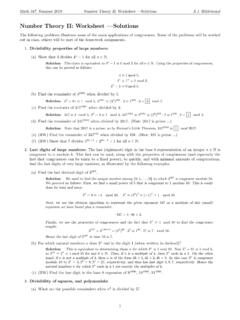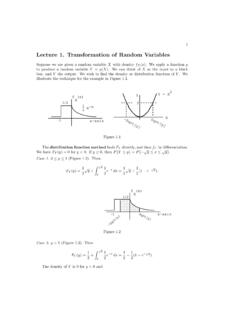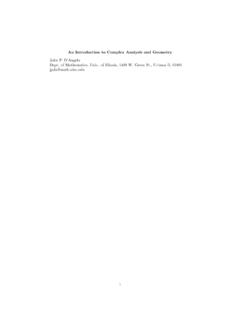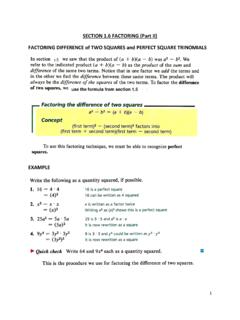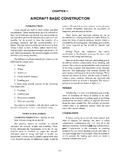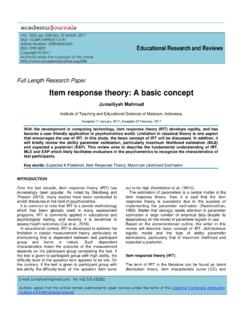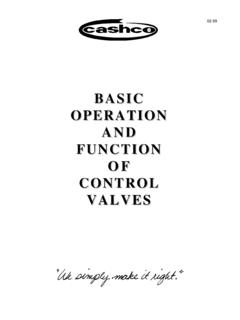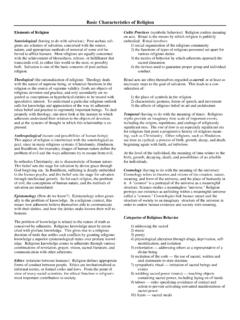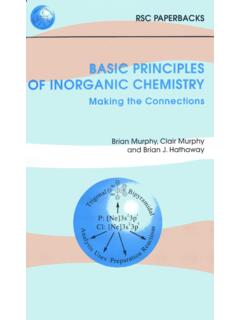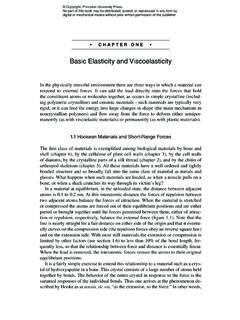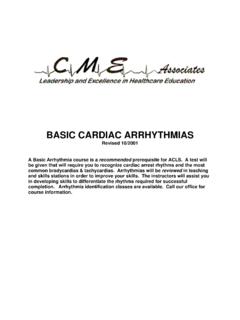Transcription of CHAPTER 2 RING FUNDAMENTALS 2.1 Basic Definitions and ...
1 Page1ofChapter2 CHAPTER 2 RING Basic Definitions and Definitions and CommentsAringRis an abelian group with a multiplicationoperation (a,b) abthat is associative and satisfies the distributive laws:a(b+c)=ab+acand (a+b)c=ab+acfor alla,b,c R. We will always assume thatRhas at least twoelements ,including a multiplicative identity 1 Rsatisfyinga1R=1Ra=afor multiplicative identity is often written simply as 1 ,and the additive identity as 0. Ifa,b ,andcare arbitrary elements ofR ,the following properties are derived quickly from thedefinition of a ring; we sketch the technique in each case.(1)a0=0a=0 [a0+a0=a(0+0)=a0; 0a+0a=(0+0)a=0a](2) ( a)b=a( b)= (ab)[0=0b=(a+( a))b=ab+( a)b ,so ( a)b= (ab); similarly,0=a0=a(b+( b)) =ab+a( b),soa( b)= (ab)](3) ( 1)( 1) = 1 [takea=1,b= 1 in (2)](4) ( a)( b)=ab[replacebby bin (2)](5)a(b c)=ab ac[a(b+( c)) =ab+a( c)=ab+( (ac)) =ab ac](6) (a b)c=ac bc[(a+( b))c=ac+( b)c)=ac (bc)=ac bc](7) 1 = 0 [If 1 = 0 then for allawe havea=a1=a0 = 0 ,soR={0} ,contradicting theassumption thatRhas at least two elements](8) The multiplicative identity is unique[If 1 is another multiplicative identity then1=11 =1 ] Definitions and CommentsIfaandbare nonzero butab= 0 ,we say thataandbarezero divisors.
2 Ifa Rand for someb Rwe haveab=ba= 1 ,we say thatais aunitor thatabneed not equalba; if this holds for alla,b R ,we say thatRis domainis a commutative ring with no zero ringorskew fieldis a ring in which every nonzero elementahas a multiplicativeinversea 1( ,aa 1=a 1a= 1). Thus the nonzero elements form a group a commutative division ring. Intuitively ,in a ring we can do addition ,subtractionand multiplication without leaving the set ,while in a field (or skew field) we can do divisionas finite integral domain is a field. To see this ,observe that ifa = 0 ,the mapx ax,x R ,is injective becauseRis an integral domain. IfRis finite ,the map issurjective as well ,so thatax= 1 for a ringR(written CharR) is the smallest positive integer suchthatn1 = 0 ,wheren1 is an abbreviation for 1 + 1 + 1(ntimes).
3 Ifn1 is never 0 ,wesay thatRhascharacteristic 0. Note that the characteristic can never be 1 ,since 1R = an integral domain and CharR = 0 ,then CharRmust be a prime number. For ifCharR=n=rswhererandsare positive integers greater than 1 ,then (r1)(s1) =n1=0,so eitherr1ors1 is 0 ,contradicting the minimality a ringRis a subsetSofRthat forms a ring under the operations ofaddition and multiplication defined onR. In other words,Sis an additive subgroup ofRthat contains 1 Rand is closed under multiplication. Note that 1 Ris automatically themultiplicative identity ofS ,since the multiplicative identity is unique (see (8) of ( )). Examples1. The integersZform an integral domain that is not a LetZnbe the integers modulon ,that is ,Zn={0,1.}
4 ,n 1}with addition and multipli-cation modn. (Ifa Znthenais identified with all integersa+kn,k=0, 1, 2,..}.Thus,for example ,inZ9the multiplication of 3 by 4 results in 3 since 12 3 mod 9 ,and therefore12 is identified with a ring ,which is an integral domain (and therefore a field ,sinceZnis finite) if andonly ifnis prime. For ifn=rsthenrs=0inZn;ifnis prime then every nonzero elementinZnhas a multiplicative inverse ,by Fermat s little theorem that by definition of characteristic ,any field of prime characteristicpcontains anisomorphic copy ofZp. Any field of characteristic 0 contains a copy ofZ ,hence a copy ofthe Ifn 2 ,then the setMn(R) of allnbynmatrices with coefficients in a ringRforms anoncommutative ring ,with the identity matrixInas multiplicative identity.)
5 If we identifythe elementc Rwith the diagonal matrixcIn ,we may regardRas a subring ofMn(R).It is possible for the product of two nonzero matrices to be zero ,so thatMn(R) is not anintegral domain. (To generate a large class of examples ,letEijbe the matrix with 1 in rowi ,columnj ,and 0 s elsewhere. ThenEijEkl= jkEil ,where jkis 1 whenj=k ,and 0otherwise.)4. Let 1,i,jandkbe basis vectors in 4-dimensional Euclidean space ,and define multipli-cation of these vectors byi2=j2=k2= 1,ij=k, jk=i, ki=j, ji= ij, kj= jk, ik= ki(1)LetHbe the set of all linear combinationsa+bi+cj+dkwherea,b,canddare realnumbers. Elements ofHare added componentwise and multiplied according to the aboverules , ,(a+bi+cj+dk)(x+yi+zj+wk)=(ax by cz dw)+(ay+bx+cw dz)i+(az+cx+dy bw)j+(aw+dx+bz cy) (after Hamilton) is called the ring ofquaternions.
6 In factHis a division ring; the inverseofa+bi+cj+dkis (a2+b2+c2+d2) 1(a bi cj dk).Hcan also be represented by 2 by 2 matrices with complex entries ,with multiplicationof quaternions corresponding to ordinary matrix multiplication. To see this ,let1= 1001 ,i= i00 i ,j= 01 10 ,k= 0ii0 ;a direct computation shows that1,i,jandkobey the multiplication rules (1) given we may identify the quaterniona+bi+cj+dkwith the matrixa1+bi+cj+dk= a+bi c+di c+di a bi (where in the matrix,iis 1 ,not the quaternioni).The set of 8 elements 1, i, j, kforms a group under multiplication; it is calledthequaternion IfRis a ring ,thenR[X] ,the set of all polynomials inXwith coefficients inR ,is also aring under ordinary polynomial addition and multiplication ,as isR[X1.]
7 ,Xn] ,the set ofpolynomials innvariablesXi,1 i n ,with coefficients inR. Formally ,the polynomialA(X)=a0+a1X+ +anXnis simply the sequence (a0,..,an); the symbolXis aplaceholder. The product of two polynomialsA(X) andB(X) is a polynomial whoseXk-coefficient isa0bk+a1bk 1+ +akb0. If we wish to evaluate a polynomial onR ,we usetheevaluation mapa0+a1X+ +anXn a0+a1x+ +anxnwherexis a particular element ofR. A nonzero polynomial can evaluate to 0 at all points ofR. For example,X2+Xevaluates to 0 onZ2 ,the field of integers modulo 2 ,since 1 + 1 = 0mod 2. We will say more about evaluation maps in Section ,when we study IfRis a ring ,thenR[[X]] ,the set offormal power seriesa0+a1X+a2X2+ with coefficients inR ,is also a ring under ordinary addition and multiplication of powerseries.
8 The definition of multiplication is purely formal and convergence is never mentioned;we simply define the coefficient ofXnin the product ofa0+a1X+a2X2+ andb0+b1X+b2X2+ to bea0bn+a1bn 1+ +an 1b1+ Examples 5 and 6 ,ifRis an integral domain ,so areR[X] andR[[X]]. In Example 5,look at leading coefficients to show that iff(X) = 0 andg(X) = 0 ,thenf(X)g(X) =0. InExample 6 ,iff(X)g(X) = 0 withf(X) = 0 ,letaibe the first nonzero coefficient off(X).Thenaibj= 0 for allj ,and thereforeg(X)= LemmaThegeneralized associative lawholds for multiplication in a ring. There isalso ageneralized distributive law:(a1+ +am)(b1+ +bn)=m i=1n j= argument for the generalized associative law is exactly the same as for groups;see the beginning of Section The generalized distributive law is proved in two setm= 1 and work by induction onn ,using the left distributive lawa(b+c)=ab+ac.
9 Then use induction onmand the right distributive law (a+b)c=ac+bcon(a1+ +am+am+1)(b1+ +bn). PropositionTheBinomial Theorem(a+b)n= nk=0 nk akbn kis valid in anyring ,ifab= standard proof via elementary combinatorial analysis works. Specifically,(a+b)n=(a+b) (a+b) ,and we can expand this product by multiplying an element (aorb) fromobject 1 (the first (a+b)) times an element from object 2 times times an element fromobjectn ,in all possible ways. Sinceab=ba ,these terms are of the formakbn k,0 k number of terms corresponding to a givenkis the number of ways of selectingkobjectsfrom a collection ofn ,namely nk . Problems For Section IfRis a field ,isR[X] a field always? sometimes? never?2. IfRis a field ,what are the units ofR[X]?
10 3. Consider the ring of formal power series with rational (a) Give an example of a nonzero element that does not have a multiplicative inverse ,andthus is not a unit.(b) Give an example of a nonconstant element (one that is not simply a rational number)that does have a multiplicative inverse ,and therefore is a LetZ[i] be the ring ofGaussian integersa+bi ,wherei= 1 andaandbare thatZ[i] is an integral domain that is not a What are the units ofZ[i]?6. Establish the following quaternion identities:(a)(x1+y1i+z1j+w1k)(x2 y2i z2j w2k)=(x1x2+y1y2+z1z2+w1w2)+( x1y2+y1x2 z1w2+w1z2)i+( x1z2+z1x2 w1y2+y1w2)j+( x1w2+w1x2 y1z2+z1y2)k(b)(x2+y2i+z2j+w2k)(x1 y1i z1j w1k)=(x1x2+y1y2+z1z2+w1w2)+(x1y2 y1x2+z1w2 w1z2)i+(x1z2 z1x2+w1y2 y1w2)j+(x1w2 w1x2+y1z2 z1y2)k(c) The product of a quaternionh=a+bi+cj+dkand itsconjugateh =a bi cj dkisa2+b2+c2+ quaternions ,then (qt) =t q.




